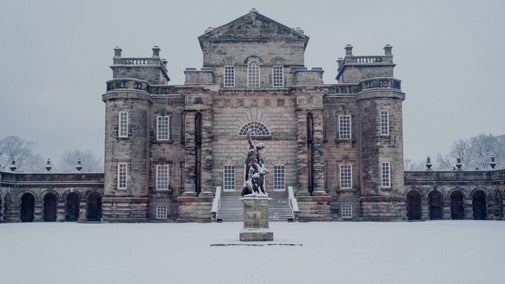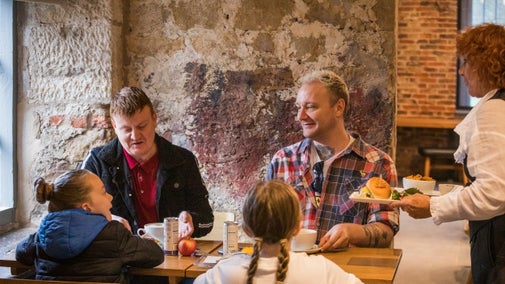
Seaton Delaval Hall to Holywell village trail
Take a walk from Seaton Delaval Hall to Holywell village on this circular route that takes in signs of the landscape's agricultural past and historical coal industry along the way. You'll also pass by Holywell Pond Nature Reserve (managed by Northumberland Wildlife Trust) and Holywell Dene, a steep-sided woodland, along this route through the Delaval Estate.
Total steps: 12
Total steps: 12
Start point
Main gates at Seaton Delaval Hall, NE26 4QR. Grid ref: NZ322766
Step 1
Leave Seaton Delaval Hall by the main gates, turn left along the pavement and follow the estate wall round to enter the grounds of the Norman Church of Our Lady using the gap in the wall if the gates are closed. Once you've looked around, retrace your steps to the main road, noticing Hall Farm, which used to be called Village Farm, to the left. Stay on this side of the road and walk up The Avenue towards the modern Seaton Delaval village. Once known as the West Avenue, this road was the private approach to the Hall and was laid out by Admiral George Delaval in 1719. It was lined by four rows of lime trees, two to each side of the carriageway.
Step 2
Immediately before the road to New Hartley, pause to look at the obelisk plinth, a reminder of what was once a tribute to Admiral Delaval. Stay on The Avenue for a few more yards until you reach a track on the left signposted 'Public Bridleway Holywell 1½ '. Until the 1960s there was a level crossing and signal box here. Turn onto the bridleway, which uses the line of the Avenue Branch of the Blyth and Tyne Railway.
Step 3
After just over ¾ mile you arrive at two kissing gates facing each other up a few steps on each side of the track, with a yellow double-headed footpath arrow on a post to your left. Go through the right-hand gate and straight ahead along the footpath beside the field. In the next field, to the right, you will catch your first sight of Holywell Pond Nature Reserve. It is a large mining subsidence pond and is managed by Northumberland Wildlife Trust. The path winds left and right, then there is a public hide just to the right of the path. Continue past the hide until the path turns left and ends between houses. When you are onto the road turn right on the pavement and right again. Go straight up this road to a T-junction.
Step 4
On your left is Strother Farm with its 17th-century house, thought to be all that is left of Sir Ralph Bates' manor house. In the field (private land) behind the manor house is a spring that was used by monks as they made their way between Tynemouth and Newsteads Abbey, near Morpeth – this is how Holywell was named.
Step 5
Carefully cross the main road and go left down the pavement to enter the steep lane on the right, signposted 'Public Bridleway' with a Heritage Way arrow. This leads to the picturesque 17th-century Holywell Bridge, an important crossing over the Seaton Burn in a leafy setting on the historic route between Tynemouth and Morpeth. At this point you can cut the walk short by retracing your steps to Strother Farm and picking up the trail from step 8. For the full walk, cross over the bridge, turn right to walk up Holywell Dene beside the burn and, if you look back over your shoulder, you'll get a good view of the bridge. Stay on the bridleway as it veers gradually left away from the burn to fields where you see the roofs of Holywell Grange Farm ahead in the distance. Stay on the track as it bends right towards trees.
Step 6
At the trees go right, waymarked with a yellow footpath arrow and a red Reivers Cycle Route arrow. Continue on the path as it runs downhill into Holywell Dene towards the burn, then veers steeply down to the right to reach a modern footbridge. Cross the bridge and turn right to walk downstream until the path turns left. Climb the flight of winding stairs up the side of the dene to a short cul-de-sac.
Step 7
Turn right and walk up to the main road, cross carefully and walk right. On your left you'll pass a group of red-brick bungalows built by the Aged Mine-Workers' Homes Association in memory of the Holywell men who died in the First World War.
Step 8
Retrace your steps along Holywell Dene Road, taking a moment to examine the Art Stop, a repurposed shelter of 1957, and the adjacent noticeboard with information about the village.
Step 9
At the end of the road go straight ahead, waymarked 'Reivers Off Road' and signposted 'Public Bridleway'. Soon you'll be able to see the Seaton Delaval Hall obelisk in the distance. Just before you reach a stone bridge go left down steps. These lead down to the Avenue Branch bridleway.
Step 10
Go left, and when you arrive back at the kissing gates that face each other across the track, go to the right, marked with a yellow footpath arrow. Go straight ahead along the path to the other side of the field, where there's another waymark post.
Step 11
The path ahead is on the track of a wagonway once used to carry coal across Holywell Dene to Seaton Sluice, but turn left along the bridleway through the metal gate, marked by a blue arrow on the post. From this track you get a good view of the obelisk, which is on private farmland and so isn't accessible. Keep an eye out for the view of Seaton Delaval Hall's south front. For much of the 18th century there was a South Avenue, similar to the West Avenue but leading the eye from the house towards the obelisk, itself placed there purely to catch the eye.
Step 12
Continue along the track and past two more metal gates to take you in front of a terrace of houses. At the end of the bridleway you are back on The Avenue and should turn right to return to Seaton Delaval Hall.
End point
Main gates at Seaton Delaval Hall, NE26 4QR. Grid ref: NZ322766
Trail map

More near here


Holywell Dene and Old Hartley walk
An easy self-guided walk taking in the points of interest around Holywell Dene and Old Hartley, including the history of the local area and Seaton Delaval Hall.

Holywell and Sluice walk at Seaton Delaval Hall
Explore Seaton Delaval Hall's estate on a circular walk in Northumberland, and discover a Norman church, a ruined castle, a nature reserve and Sluice Harbour.

Wagonway walk at Seaton Delaval Hall
This gentle trail starts from Seaton Delaval Hall and takes in much of the wider estate, incorporating local points of interest and historical facts about the Delaval family.
Get in touch
The Avenue, Seaton Sluice, Northumberland, NE26 4QR
Our partners

We’ve partnered with Cotswold Outdoor to help everyone make the most of their time outdoors in the places we care for.
You might also be interested in

Walking
Explore some of the finest landscapes in our care on coastal paths, accessible trails, woodland walks and everything in between. Find the best places to walk near you.

Walking in the North East
From a trek through the largest area of ancient woodland in Northumberland to a walk in the footsteps of the Romans along Hadrian's Wall, there are some amazing places to walk in the North East.

Cotswold Outdoor: our exclusive walking partner
Find out more about the National Trust’s ongoing partnership with Cotswold Outdoor as our exclusive walking partner.

Follow the Countryside Code
Help to look after National Trust places by observing a few simple guidelines during your visit and following the Countryside Code.

Staying safe at National Trust places
The special places in National Trust care sometimes come with a few risks for visitors, be it coastline or countryside. Find out how to keep safe throughout your visits.

Eating at Seaton Delaval Hall
During your visit to Seaton Delaval Hall, stop by the Brewhouse Café. Housed in a 17th-century building, it offers a wide range of drinks and snacks, as well as indoor and outdoor seating.

Explore the garden at Seaton Delaval Hall
Find out what you’ll discover in the varied garden at Seaton Delaval Hall, from a Parterre and Rose Garden to a centuries-old weeping ash and woodland waiting to be explored.